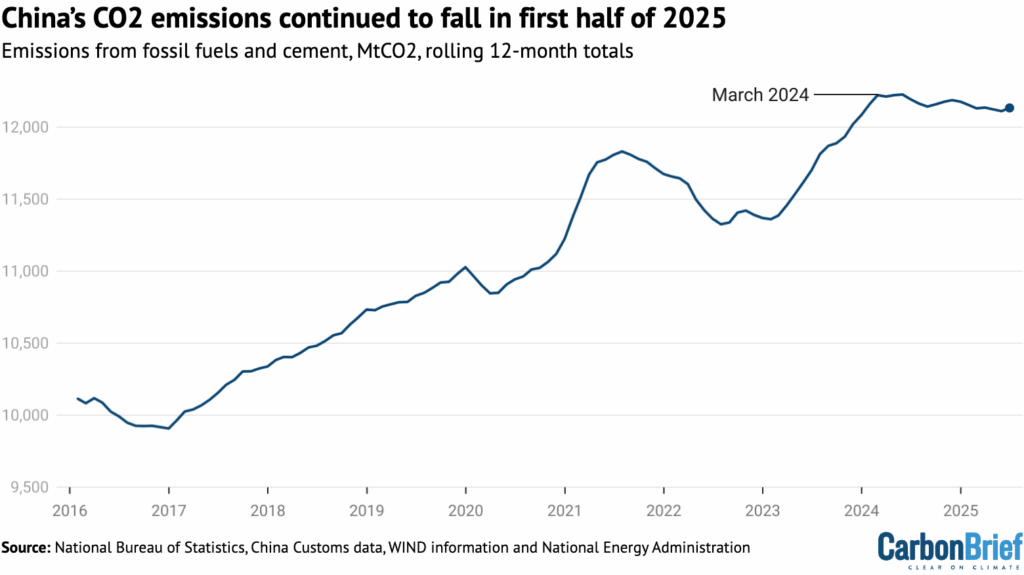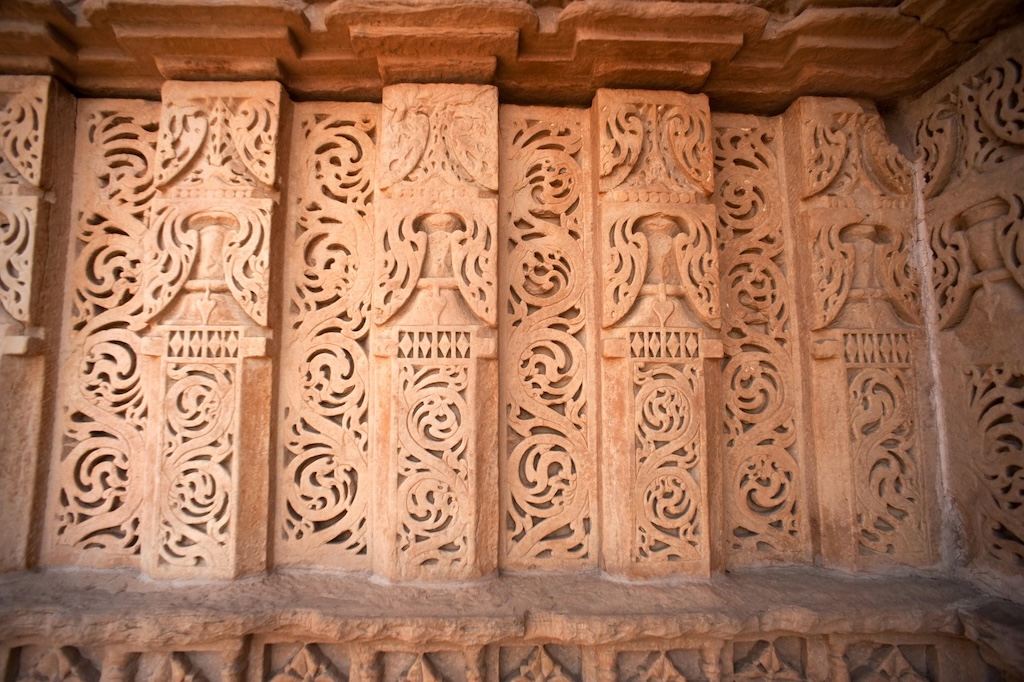
DeBriefed 22 August 2025: Pakistan floods; China emissions drop; Climate-adaptive architecture
Molly Lempriere
08.22.25Molly Lempriere
22.08.2025 | 1:56pmWelcome to Carbon Brief’s DeBriefed.
An essential guide to the week’s key developments relating to climate change.
This week
Floods and fires
PAKISTAN FLOODS: Torrential rain in northern Pakistan killed almost 400 people over five days, Agence-France Press reported. The rains have caused flooding and landslides that have “swept away entire villages, leaving many residents trapped in the rubble and scores missing”, it added. Bloomberg reported that the monsoon season has killed at least 1,860 people in India and Pakistan, “with flash floods, landslides and inundated cities exposing the region’s growing vulnerability to climate-related disasters”.
HEAVY RAIN IN CHINA: In China’s Inner Mongolia province, 13 people have been killed in floods caused by heavy rains, reported Reuters. It added that “heavy rainfall and severe floods that meteorologists link to climate change” are posing “major challenges”, including “economic losses running into billions”.
SPANISH WILDFIRES: Spain has continued to battle several major wildfires, even as temperatures across the country began to drop, reported the Associated Press. The fires have burned a total area twice the size of London this year, added the Daily Telegraph. The emissions from the wildfires have “surged to their highest levels in at least 23 years”, reported the Independent.
Around the world
- TRUMP REPORT ‘IRREGULARITIES’: A former head at the US Environmental Protection Agency has requested a correction to a recent misleading climate report from the Department of Energy, citing “legal and procedural irregularities”, reported Politico.
- SOARING SOLAR: Solar power generation in Britain has already surpassed the total for 2024, with more than 14 terawatt hours of electricity produced as of 16 August, the Financial Times reported.
- ‘CLASH OF VIEWS’: Incoming president of the COP30 climate summit, Brazilian diplomat André Corrêa do Lago, is preparing for a “clash of views” over how countries should respond to a review of their overdue climate plans, according to Climate Home News.
- TAX CREDITS: The US treasury department has issued guidance that “narrows which wind and solar energy projects” can receive the remaining tax credits set to be “largely eliminated” by the Republicans’ “big beautiful bill”, reported the Hill.
195%
The record increase in UK renewable energy capacity to gain planning permission in the second quarter of this year, when compared to the same period in 2024, reported the Financial Times.
Latest climate research
- The risk of rice production failure across Indian districts could increase by 26%, on average, due to climate change by 2055-84 | Environmental Research Letters
- Newborns across 33 African countries are more likely to die if their mothers are exposed to extreme heat during pregnancy | PNAS Nexus
- More than 13,800 square kilometres of giant panda habitat could “degrade” under a moderate-warming scenario | Global Change Biology
(For more, see Carbon Brief’s in-depth daily summaries of the top climate news stories on Monday, Tuesday, Wednesday, Thursday and Friday.)
Captured

Clean-energy growth helped China’s carbon dioxide (CO2) emissions fall during the first half of the year, despite an increase in electricity demand, new analysis for Carbon Brief found. Emissions in the first half of the year fell by 1% year-on-year, extending a declining trend that started in March 2024, the analysis said. CO2 output fell in China’s power sector by 3%, with the growth in solar power alone matching the rise in electricity demand in the country. Emissions also fell in the building materials, steel and heating industries sectors, the analysis added.
Spotlight
How architecture can support climate-adaptive design
This week, Carbon Brief interviews Prof Alice Moncaster, professor of sustainable construction at the University of the West of England, about how architecture can adapt to the growing pressures of climate change.
Carbon Brief: What are the biggest challenges with designing climate-adaptive buildings?
Alice Moncaster: Climate change is already producing far more frequent and extreme heatwaves across most of the world, as well as more severe storms leading to flash flooding and failing roof and subsurface drainage systems, and long periods of drought, meaning water shortages and shrinking ground leading to cracking buildings.
There are two huge challenges for designing buildings that can physically withstand these extremes. The first is perhaps the easier, which is the design of new buildings. This is critical in developing nations where rapidly increasing and urbanising populations need a parallel expansion in their built environment.
The second is more complex and often seen as less exciting, but is essential to developed countries with a mature building stock and lower or no population growth – how to retrofit our existing buildings from all previous decades to withstand the new weather.
Really, there is a third, less talked about challenge. At the same time as designing and retrofitting for increasingly extreme climates, this major construction programme needs to add the very minimum to greenhouse gas emissions. We cannot just continue to throw money and materials at adaptation because, at the same time, we need to reduce our carbon emissions as much as possible in order to limit further climate change.
CB: There is a lot of focus on air conditioning (AC) currently, but how can the architectural design of a building also help to keep people cool in a warming climate?
AM: This is becoming a huge issue. AC not only uses energy, but adding portable AC units kicks heat out of the building, making the outside even hotter. Passive design strategies have existed for millennia in hotter countries.
These are focused on four approaches.
First, ventilation is increasingly an issue in countries where buildings are constructed to keep the warmth in and, therefore, are built to be airtight. A passive approach is to design in a stack or chimney effect, with an opening at the top of the building, often above a central atrium.
Second, the thermal inertia of a building has long been understood as essential for keeping buildings cool in hot summers. Rather than plasterboard, if wall or floor surfaces are exposed stone, brick or concrete, they will stay cool for many hours longer (as anyone who has been in an old church will know).
A method which combines ventilation with thermal inertia is a “jaali wall”, a perforated stone or brick screen used in some traditional Asian architecture.

Third, shading the outside of the building from the sun is essential. Many Mediterranean buildings include external shutters, which keep the sun off the windows.
The final approach is how the building is used. Bedroom spaces are often moved in hotter countries to cooler areas of the house or even outside.
CB: Do you think there is enough centering of climate-adaptive design within architectural practice currently?
AM: I believe that there is a huge amount of knowledge among our architects and building professionals about climate-adaptive – and climate-mitigating – design, but that it is very hard to make it actually happen.
I think it is partly due to the slow-to-change nature of the construction sector, across skills, materials and supply chains. But I increasingly think that underlying the sector are the powerful vested interests, which means that traditional materials still dominate.
Procurement practices also often do little to support innovation and the understanding of risk has not yet caught up with the very real risk of climate change.
Watch, read, listen
MASS EXTINCTION: A long read in the Guardian questioned whether climate change is leading towards “another Great Dying”.
A GOOD PLANET: On a New Scientist podcast, climate scientists Kate Marvel and Tim Lenton discussed how to fix climate change, quipping: “All of the other planets out there are just complete garbage. The Earth is the only good place.”
COOLED VS COOKED: A guest essay in the New York Times discussed the new American inequality – those who are “cooked” and those who are “cooled” – as extreme heat becomes increasingly common in the US.
Coming up
- 26-29 August: 6th Forum of Ministers and Environment Authorities of Asia Pacific, Fiji
- 24-28 August: World Water Week 2025, Stockholm, Sweden
- 27 August: UN Environment Programme sixth meeting of the open-ended ad hoc group on measurability and indicators, online
Pick of the jobs
- British Antarctic Survey, project manager – Rothera Renewable Energy | Salary: £56,509-£62,159. Location: Cambridge/Antarctica
- ClientEarth, UK environment lawyer | Salary: £56,991. Location: London
- The New York Times, deputy editor, climate desk | Salary: $150,000-$175,000. Location: Hybrid/New York
- Indigenous Climate Action, climate leadership coordinator | Salary: $55,000- $65,000. Location: Remote
- India Climate Collaborative, programme manager – heat | Salary: Unknown. Location: Mumbai/ Delhi/Bengaluru
DeBriefed is edited by Daisy Dunne. Please send any tips or feedback to [email protected].
This is an online version of Carbon Brief’s weekly DeBriefed email newsletter. Subscribe for free here.



